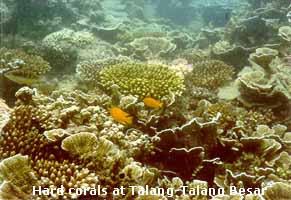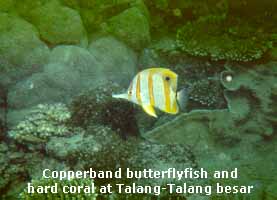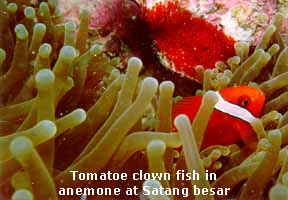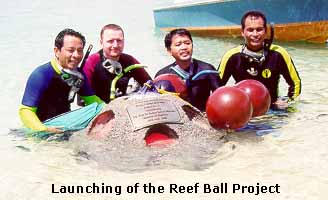
Article courtesy of The Sarawak Tribune 
The bad news is that two-thirds of the earth's coral reef are dying. It is estimated that 10 percent of the world's reefs have already been degraded beyond recovery and a much larger percentage is now threatened. The good news, however, is that Sarawak has set a model for the rest of Asia in planned and responsible marine conservation by deploying Reef Balls, which will extend and increase the existing coral and build new reefs, writes Nikki Lugun.
They looked like something brought in from an alien planet but one
description I feel best describes Reef Balls, is a gigantic Swiss cheese in the
shape of a football cut in half. Little did the marine creatures and fishes
below the surface of the sea know that this would be their new homes. It may
look like a concrete eyesore but it looks completely different to fishes. 
These condo style living is devised especially for fish since they naturally congregate around reefs for food and shelter. In time to come, marine organisms and coral will encrust and attach to these objects and they will be the source of food for other marine creatures. In addition, they will serve as "mines" to rip the nets of trawlers, which are probably the largest culprit responsible for destroying marine life especially turtles.
Man's activities and natural disasters have led to a reduction in our natural reef systems. Recreationally, growth in sports fishing, scuba diving and destructive style of commercial fishing has increased the pressures on these systems. Commercially, our seafood industry is dependent on developing the ocean to enable even larger, yet sustainable, harvests.
The loss of these natural systems, coupled with increased use, compels the Sarawak government to do everything they can to save natural reefs. Even so, the natural reefs cannot rebuild themselves fast enough to meet human demands. Long lasting artificial reefs are useful tools for restoring the reef systems to a natural and productive balance.
Coral reefs are a rare feature in Sarawak due to its shallow sea shelf
extending a long way into the ocean. The reefs of Sarawak are limited to the
areas off the shores of Bintulu, Miri and off shore islands including the
Talang-Satang region. There is a lack of rocky bottoms and the presence of many
rivers on the mainland cause the sea bed to have a clay bottom. 
The Talang-Talang region situated off the coast of Sematan is especially important as it is one of the most diverse ecosystems found off Sarawak. They are the home and nursery for thousands of species of marine life and is the nesting habitats of the endangered marine turtles. Around 95% of all turtle landings in Sarawak are found at the Talang Talang region, also known as the Turtle Islands.
The Sarawak government has taken another historical step forward in its conservation efforts by proposing the Talang-Satang National Park. This will augment and extend the existing turtle sanctuary under the jurisdiction of the Sarawak Turtles Board. In June this year, the Sarawak Reef Ball Working Group Project 1 for the Talang-Talang region was launched. The Project and the formation of the Sarawak Reef Ball Working Group was carried out to oversee all proposed reef ball projects in the State and ensure a coordinated approach to marine life conservation.
It comprises officials from the Forestry Department (project coordinator), Marine Fisheries, Marine Department, Marine Police, Sarawak Museum, Sarawak Turtle Board, Ministry of Tourism, Sarawak Tourism Board, Ministry of Environment and Public Health, Ministry of Social Development and the Natural Resource and Environment Board.
The government is working in collaboration with the Reef Ball Development Group Ltd, a voluntary group from the United States which is currently conducting over 30 projects worldwide. Reef Balls present the world's most advanced artificial reef technology and restores the world's oceans and saving our ocean ecosystem.
The seas around the Talang-Talang region will be 'seeded' with these 500 reef balls. Half were dropped last month, and the other half will be dropped early next year once the Landas has finished. According to project leader Ian Butler,marine biologist attached to the National Parks and Wildlife Division of the Forestry Department, 12 test reef balls which were embedded on the sea floor a few months ago already showed a rate of success with approximately 6cm of soft coral growing upon them.
Under the proposed Second Project, around 5,000 reef balls will be deployed along the coast especially in existing reef areas to extend the reef. The Forestry Department is currently looking for more funding to implement this project. The first project cost RM350,000 and was funded mainly by the Sarawak Ministry of Environment and Public Health. This initial cost was much higher than that for further proposed projects because it included the cost of purchasing the infrastructure for manufacturing the reef balls, as well as funding two experts to come from the USA for a two week training session.
During the launch of Phase 1 in June this year, Minister for Environment and Public Health YB Datuk James Wong Kim Min said that he has agonised over the problem of how to conserve sea turtles in Sarawak. It is his belief that illegal trawling activity is one of the largest culprits responsible for killing many turtles without our knowledge. He believes that the only truly effective way to deter these illegal trawlers is to seed the sea bed around the Turtle Islands with reef balls that will act as "mines" to rip their nets to shreds.
En. Ismaili Bujang Pit, Officer in charge of Enforcement for the Marine Fisheries Department Sarawak commented that these reef balls will help in their enforcement against illegal trawling. They will no longer trawl in the region because of a fear of ruining their nets and possibly sinking their vessels. This should prove a more cost effective method than trying to chase these errant trawlers after they have already entered the region. He also added that his Department is seriously considering the use of reef balls for other areas in Malaysia.
During the launch of the Phase 2 of the Sarawak Reef Ball Working Group project No. 1 for the Talang-Talang region last month, Tourism Minister Dato Dr James Masing said that the reef balls would allow the growth of new coral reefs and to provide alternative dive sites to encourage eco-tourism. However, he stressed that the primary purpose of using the reef balls was for conservation. He also added that Sarawak has sanctuaries for animals but not for fish and other marine life. The creation of sanctuaries for corals and fish to breed will be of great benefit for the local fishermen because it will increase the fish stocks in the area.
Dr. Charles Leh, zoologist from the Sarawak Museum commented that the reef balls will be useful to provide further habitat for the turtles to rest in between their egg laying sessions. These extra "nooks and crannies" will also act to provide further hiding places for the turtles from potential predators.
The proposed Talang-Satang National Park is in the final stages of constitution and after that, a permit will be necessary from the Forestry Department. Batu Penyu, located close to the Talang-Talang islands will be set up as a dive site for local divers which will give an alternative to the illegal scuba diving that has been going on around the region.
Reef Balls 
For many decades, man has been dumping tyres, cement blocks, gallon drums,
old refrigerators and cars to build artificial reefs. The Reef Ball Development
Group Ltd., have devised a plan to help restore the ocean ecosystems through the
development and use of aestically pleasing, ecologically sound and economically
designed artificial reefs. These reef balls which are also artificial reefs
function better as they mimic nature.
The reef balls are proven to be better than any other artificial reefs as they contain no toxins or biologically active compounds. They are also stable and can last up to 500 years and have a special concrete mixture which has the same pH as salt water.
The reef balls used for the project are made in Kuching and modelled after the types used and proven to be very successful by the group. They are made by pouring marine friendly concrete into a fiberglass mould containing central polyform buoy surrounded by various sized inflatable balls to make holes. They are made in three sizes with the smallest being the bay all while the pallet and reef balls are the middle and largest respectively. The texture enhance the settlement of marine life.
The reef ball can be towed behind a boat and once on site, the bladder is deflated and removed. Divers can also place the reef ball precisely on the sea floor. They can also be deployed by barge.
They are placed in clusters close to the existing natural coral reef areas and this will increase the chances of coral larvae settling and growing.
The Reef Balls is a conservation development of the 21st century, only it has arrived a couple of years early.